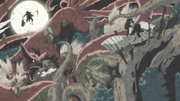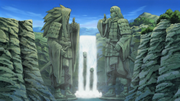No edit summary Tag: sourceedit |
m (Manual of Style) Tag: apiedit |
||
| (One intermediate revision by one other user not shown) | |||
| Line 8: | Line 8: | ||
Years later, at the end of Part I, [[Naruto Uzumaki]] chased the now missing-nin and also Naruto's teammate, [[Sasuke Uchiha]] to the valley in order to bring him back to the village before the latter attempted to kill him to acquire the [[Mangekyō Sharingan]]. Ultimately, using their greatest attacks at the same time, the battle ended with Sasuke emerging as the victor, with the statues of Madara and Hashirama receiving moderate damage during the fight.<ref>Chapters 217-233</ref> |
Years later, at the end of Part I, [[Naruto Uzumaki]] chased the now missing-nin and also Naruto's teammate, [[Sasuke Uchiha]] to the valley in order to bring him back to the village before the latter attempted to kill him to acquire the [[Mangekyō Sharingan]]. Ultimately, using their greatest attacks at the same time, the battle ended with Sasuke emerging as the victor, with the statues of Madara and Hashirama receiving moderate damage during the fight.<ref>Chapters 217-233</ref> |
||
| + | [[File:VOTE destroyed.png|thumb|The valley destroyed during Naruto and Sasuke's rematch.]] |
||
| − | <gallery type="slideshow" position="right" widths="240"> |
||
| − | Damaged_statues_VOTE.png|The statues severely damaged as a result of Naruto and Sasuke's fight. |
||
| − | VOTE destroyed.png|The statues are completely destroyed. |
||
| − | </gallery> |
||
In Part II, [[Tobi]] goes to the valley and sits atop Madara's statue as he muses over what path Sasuke will take.<ref>Chapter 370, page 16</ref><ref>Chapter 371, page 2</ref> Moments after the [[Fourth Shinobi World War]], Naruto and Sasuke once again arrive to the valley for a rematch.<ref>Chapter 693, pages 13-14</ref> The two devastated the valley, leaving much of it destroyed by the end with Naruto as the victor.<ref>Chapter 698, page 8</ref> Much of both statues were completely destroyed, leaving only the two hands, one from each statue, forming the [[Hand Seals#Seal of Reconciliation|Seal of Reconciliation]], symbolising Naruto and Sasuke's reconciliation and having finally settled their differences. |
In Part II, [[Tobi]] goes to the valley and sits atop Madara's statue as he muses over what path Sasuke will take.<ref>Chapter 370, page 16</ref><ref>Chapter 371, page 2</ref> Moments after the [[Fourth Shinobi World War]], Naruto and Sasuke once again arrive to the valley for a rematch.<ref>Chapter 693, pages 13-14</ref> The two devastated the valley, leaving much of it destroyed by the end with Naruto as the victor.<ref>Chapter 698, page 8</ref> Much of both statues were completely destroyed, leaving only the two hands, one from each statue, forming the [[Hand Seals#Seal of Reconciliation|Seal of Reconciliation]], symbolising Naruto and Sasuke's reconciliation and having finally settled their differences. |
||
{{-}} |
{{-}} |
||
| Line 19: | Line 16: | ||
* In the [[Wikipedia:Studio Pierrot|Studio Pierrot]] produced anime cutscenes of ''[[Naruto Shippūden: Ultimate Ninja Storm Generations]]'', both the start and end of Hashirama and Madara's battle were greatly elaborated. During this depiction, it was shown that a single deflected [[Tailed Beast Ball]] from Kurama resulted in the formation of the Valley of the End. |
* In the [[Wikipedia:Studio Pierrot|Studio Pierrot]] produced anime cutscenes of ''[[Naruto Shippūden: Ultimate Ninja Storm Generations]]'', both the start and end of Hashirama and Madara's battle were greatly elaborated. During this depiction, it was shown that a single deflected [[Tailed Beast Ball]] from Kurama resulted in the formation of the Valley of the End. |
||
* In Tobi's ''recollection'' of the events, Madara was stabbed through the front.<ref>Chapter 399, page 12</ref> In Hashirama's retelling of the events, he had actually stabbed Madara from behind.<ref>Chapter 626, page 14</ref> |
* In Tobi's ''recollection'' of the events, Madara was stabbed through the front.<ref>Chapter 399, page 12</ref> In Hashirama's retelling of the events, he had actually stabbed Madara from behind.<ref>Chapter 626, page 14</ref> |
||
| − | *Originally, there were two rocks in the |
+ | *Originally, there were two rocks in the centre of the waterfall that separates the two statues. However, during Naruto and Sasuke's final battle, the two rocks are noticeably missing. |
== References == |
== References == |
||
Revision as of 14:13, 16 April 2015
| This article is about the place in the Land of Fire. For the chapter of the same name, see The Valley of the End. |

The battle that formed the valley.
The Valley of the End (終末の谷, Shūmatsu no Tani, English TV: Final Valley) is located close to the border of the Land of Fire and the Land of Sound.[1] Shortly after the foundation of Konoha, the Senju's leader, Hashirama Senju became the First Hokage, much to the dismay of the fallen Uchiha leader, Madara Uchiha, who intended to destroy the village with the forced assistance of Kurama — the Nine-Tails. The valley was carved out by Hashirama's Top Transformed Buddha's barrage. The battle ended with Hashirama victorious, Madara escaping his death and going into hiding, and Kurama being sealed within Hashirama's wife, Mito Uzumaki.

The statues bordering the valley (Madara, left; Hashirama, right).
The destructive power displayed in the epic battle left a scar in the earth that would come to be called the Valley of the End.[2][3] With the waterfall serving as a border between the Land of Fire and the land that was later known as the Land of Sound, the valley was later memorialised with two giant statues of the main combatants: Hashirama on the Land of Fire's side of the waterfall and Madara on the opposite side to symbolise his defection from their village.[2] The statues are posed to make the Traditional Shinobi Sparring's Seal of Confrontation, which is protocol before a duel.
Years later, at the end of Part I, Naruto Uzumaki chased the now missing-nin and also Naruto's teammate, Sasuke Uchiha to the valley in order to bring him back to the village before the latter attempted to kill him to acquire the Mangekyō Sharingan. Ultimately, using their greatest attacks at the same time, the battle ended with Sasuke emerging as the victor, with the statues of Madara and Hashirama receiving moderate damage during the fight.[4]
The valley destroyed during Naruto and Sasuke's rematch.
In Part II, Tobi goes to the valley and sits atop Madara's statue as he muses over what path Sasuke will take.[5][6] Moments after the Fourth Shinobi World War, Naruto and Sasuke once again arrive to the valley for a rematch.[7] The two devastated the valley, leaving much of it destroyed by the end with Naruto as the victor.[8] Much of both statues were completely destroyed, leaving only the two hands, one from each statue, forming the Seal of Reconciliation, symbolising Naruto and Sasuke's reconciliation and having finally settled their differences.
Trivia
- The valley was part of the background in the fifth and twelfth Naruto: Shippūden openings.
- In the Studio Pierrot produced anime cutscenes of Naruto Shippūden: Ultimate Ninja Storm Generations, both the start and end of Hashirama and Madara's battle were greatly elaborated. During this depiction, it was shown that a single deflected Tailed Beast Ball from Kurama resulted in the formation of the Valley of the End.
- In Tobi's recollection of the events, Madara was stabbed through the front.[9] In Hashirama's retelling of the events, he had actually stabbed Madara from behind.[10]
- Originally, there were two rocks in the centre of the waterfall that separates the two statues. However, during Naruto and Sasuke's final battle, the two rocks are noticeably missing.
